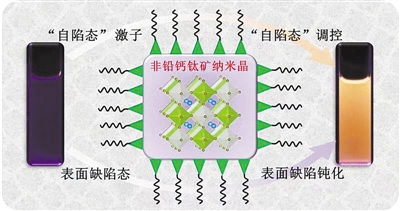
Schematic diagram of flexible sodium ion micro-supercapacitor
Using sea urchin-like sodium titanate as the negative electrode and porous activated graphene as the positive electrode, what kind of "sparks" will occur when they are combined? The reporter recently learned from the Dalian Institute of Chemical Physics, Chinese Academy of Sciences that the team of Wu Zhongshuai's researcher cooperated with the team of Academician Bao Xinhe to combine "sea urchin" with graphene to develop a flexible sodium ion micro-miniature with high energy density and high heat resistance Super capacitor.
Miniature sensors, miniature robots, self-powered microsystems, etc. are inseparable from miniature electrochemical energy storage devices. This device mainly refers to a type of miniaturized power supply with an electrode size in the micrometer range, which is considered to be flexible, miniaturized, intelligent The key power sources for integrated electronic products are currently divided into micro batteries and micro super capacitors, and hybrid micro super capacitors that have appeared in recent years.
According to reports, micro batteries have higher energy density, but their power density is lower; micro super capacitors have higher power density, but their energy density is lower. Hybrid micro-supercapacitors combine the advantages of high energy density of micro-batteries and high power density of micro-supercapacitors to become a new type of micro-electrochemical energy storage device, of which the more representative one is the lithium-ion micro-super capacitor Capacitors.
Lithium-ion micro-supercapacitors have higher energy density and power density, but their large-scale application is subject to the resource limitations of metal lithium and higher development costs (lithium crustal abundance is 0.006%). On the contrary, sodium has rich crust resources, accounting for 2.74%, with relatively low development cost, and similar electrochemical performance to lithium. The development of sodium ion micro-supercapacitors has important application prospects.
The R & D team of Dalian Institute of Chemical Research, Chinese Academy of Sciences used sea urchin-shaped sodium titanate as the battery-type negative electrode, porous activated graphene as the capacitor-type positive electrode, combined with high-pressure ionic liquid gel electrolyte, and successfully constructed a flexible sodium ion mini supercapacitor. Through the effective coupling of the battery-type negative electrode and the capacitor-type positive electrode, the sodium ion micro-supercapacitor can work stably at a high voltage of 3.5 volts, with a high energy density of 37.1 milliwatt hours / cubic centimeter and an ultra-low self-discharge rate.
According to the R & D staff, the sodium ion micro-supercapacitor has multi-directional rapid ion diffusion channels, which greatly reduces the charge transfer resistance and significantly increases the power density. At the same time, due to the planar geometry of the device and the non-flammability of the ionic gel electrolyte, the micro-device has good mechanical flexibility and high temperature stability at 80 ° C. (Reporter Hao Xiaoming)
Light Stabilizer,Silane Adhesive,Organic Pharmaceutical Synthesis Intermediates,Cas 2530-85-0 In Stock
Henan Tianfu Chemical Co.,Ltd , https://www.tianfuchem.com
